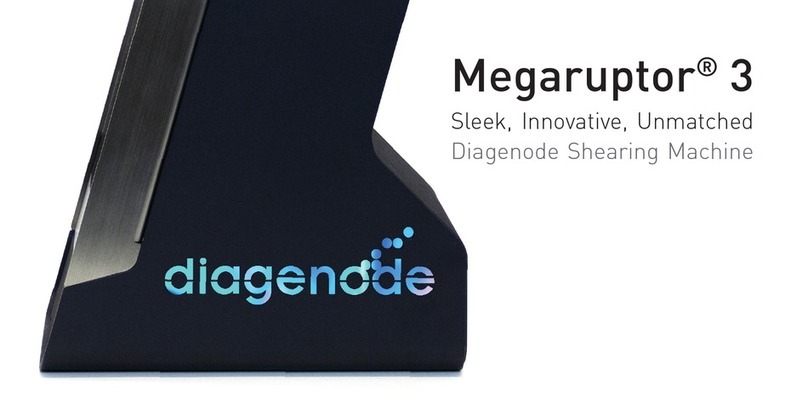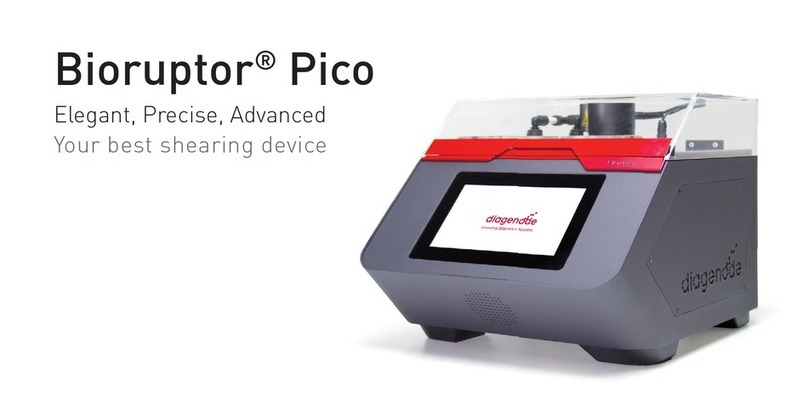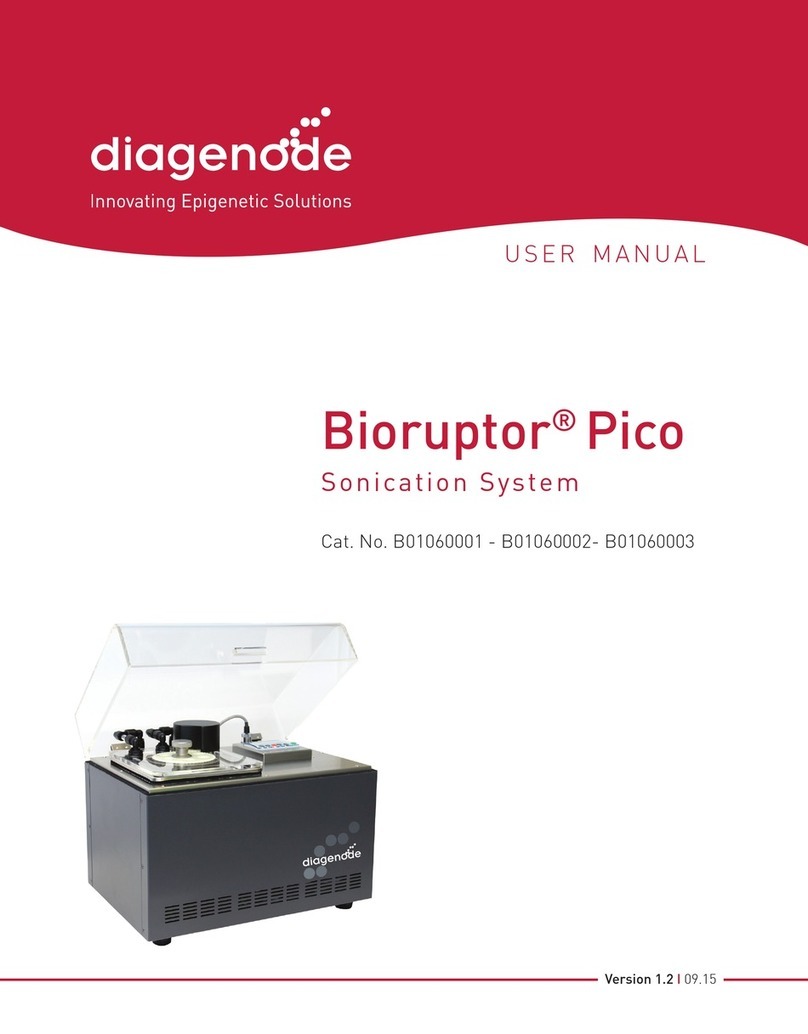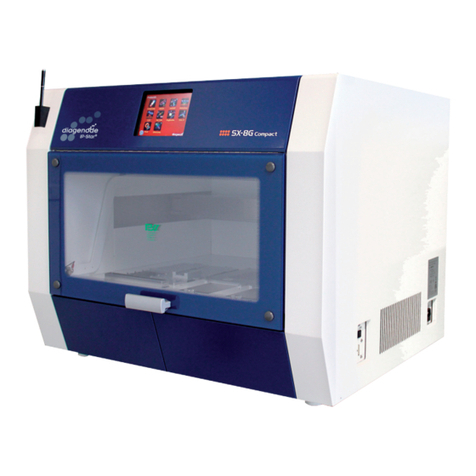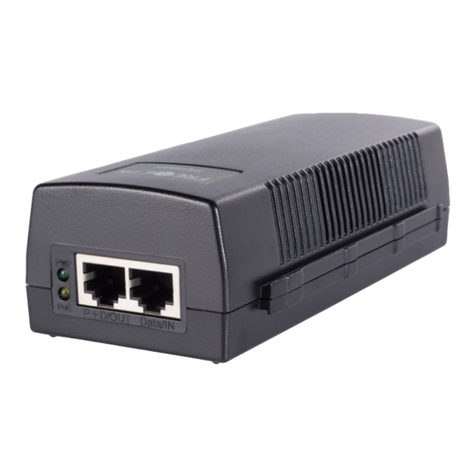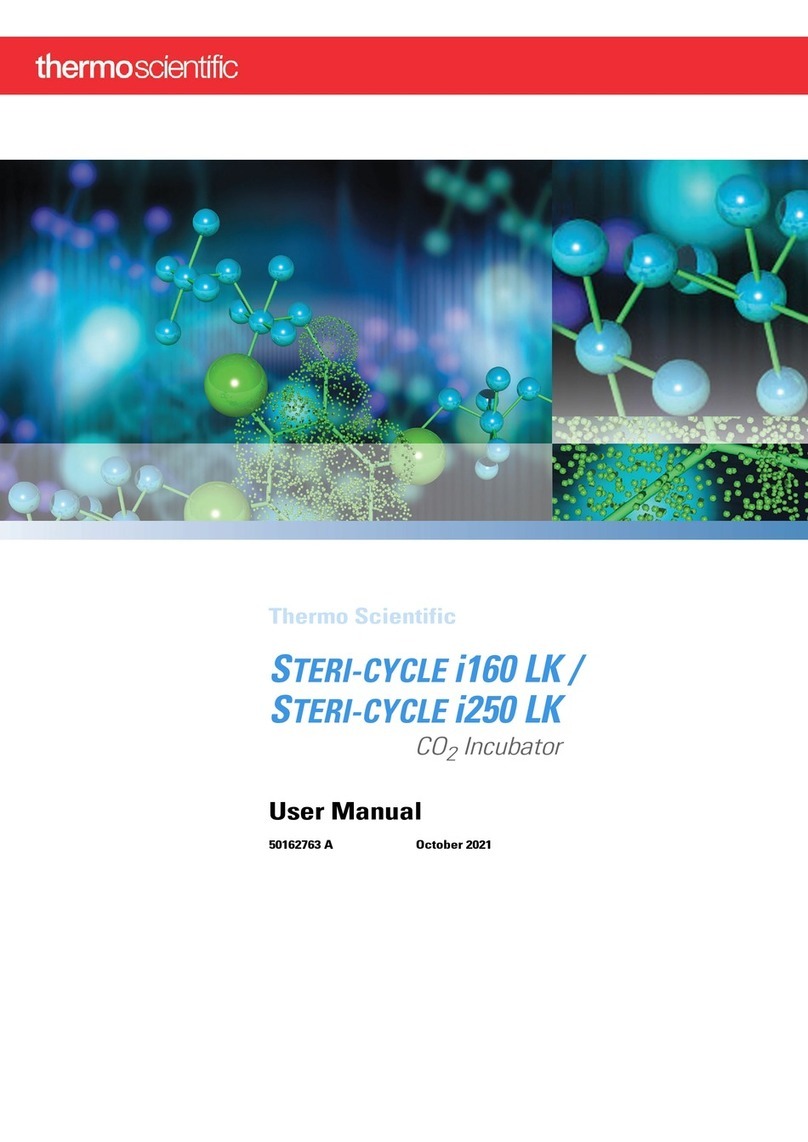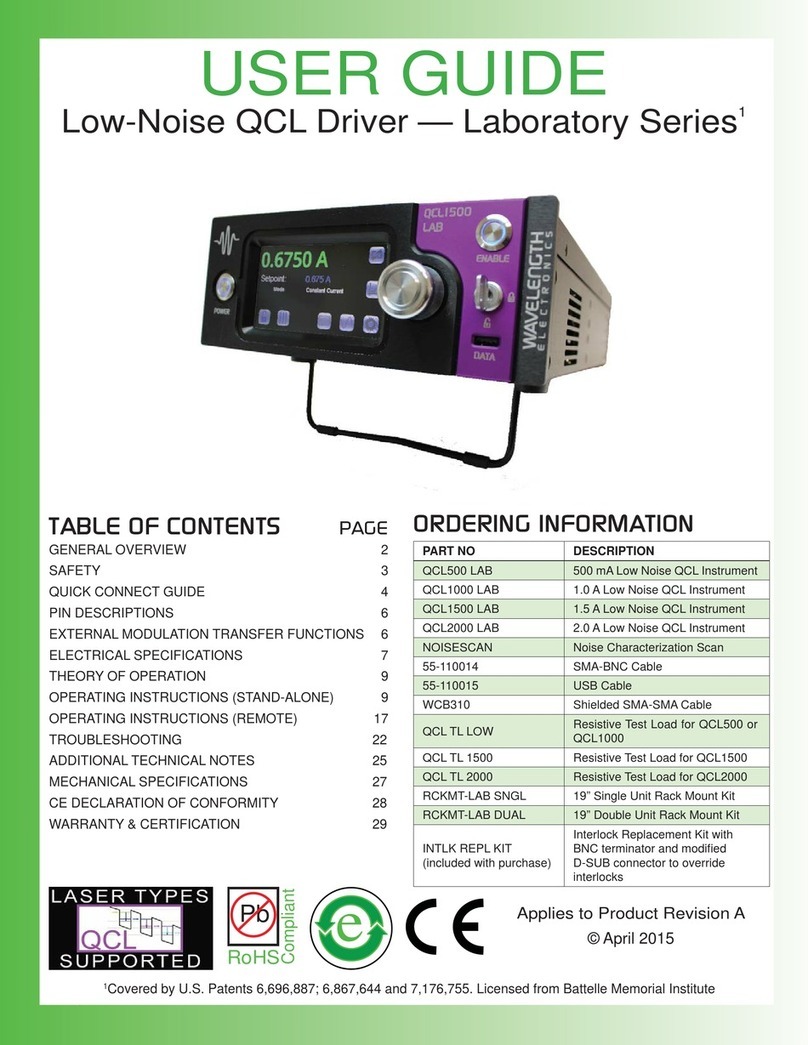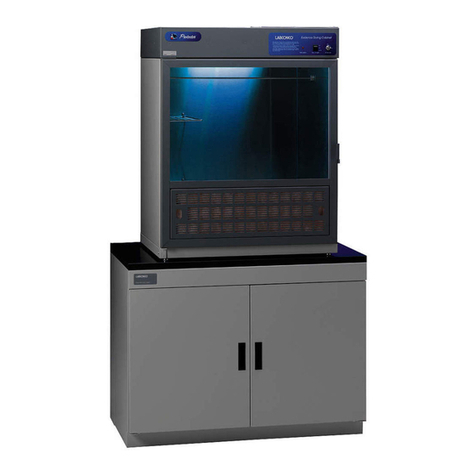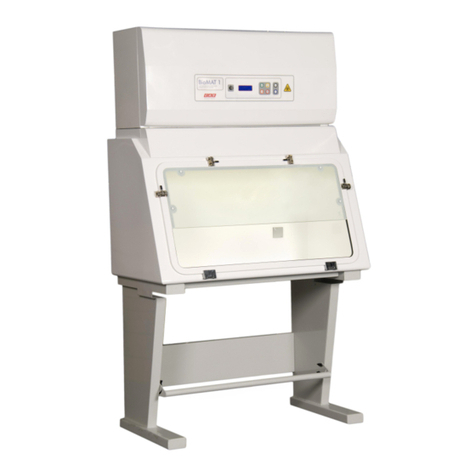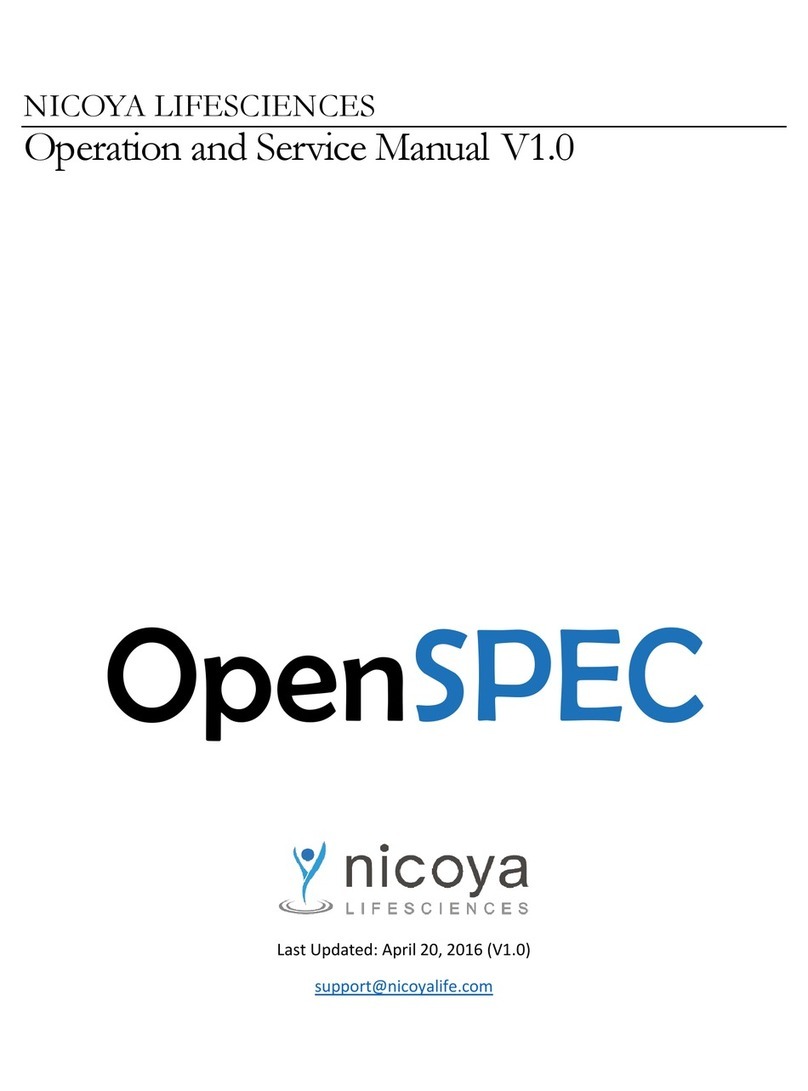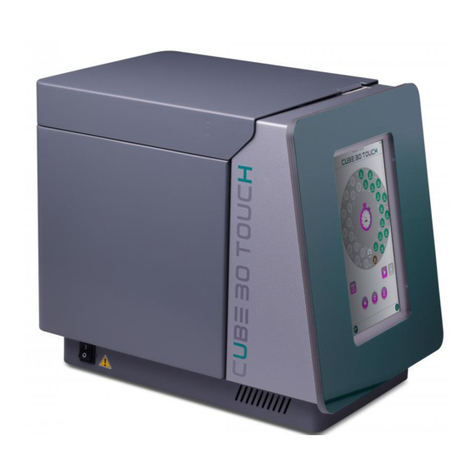diagenode Bioruptor Standard User manual

The Ultimate Guide for
Chromatin Shearing Optimization
with Bioruptor® Standard and Plus
USER'S GUIDE

2
FOR RESEARCH USE ONLY.
Not intended for any animal or human therapeutic or diagnostic use.
© 2012 Diagenode SA. All rights reserved. No part of this publication may be reproduced, transmitted, transcribed, stored in
retrieval systems, or translated into any language or computer language, in any form or by any means: electronic, mechanical,
magnetic, optical, chemical, manual, or otherwise, without prior written permission from Diagenode SA (hereinafter,
"Diagenode”) . The information in this guide is subject to change without notice. Diagenode and/or its affiliates reserve the
right to change products and services at any time to incorporate the latest technological developments. Although this guide
has been prepared with every precaution to ensure accuracy, Diagenode and/or its affiliates assume no liability for any errors
or omissions, nor for any damages resulting from the application or use of this information. Diagenode welcomes customer
input on corrections and suggestions for improvement.
TRADEMARKS
The trademarks mentioned herein are the property of Diagenode or their respective owners. Bioruptor® is a registered
trademark of Diagenode SA.
Bioanalyzer is a trademark of Agilent Technologies. Gel Logic 1500 Imaging System & Kodak Molecular Imaging Software is
a trademark of Kodak.

3
1. Protocols and Guidelines 4-21
Critical points for chromatin shearing 4
Tube holders & tubes for Bioruptor® chromatin shearing 4
Important additional comments about chromatin shearing 6
Standard protocol for chromatin shearing from Chromatin Shearing Optimization kit-Low SDS
10
A. Cell collection and DNA-protein cross-linking 10
B. Cell lysis and chromatin shearing 11
C. Sheared chromatin analysis 12
Standard protocol for chromatin shearing from Chromatin Shearing Optimization kit-Medium SDS
1 4
A. Cell collection and DNA-protein cross-linking 14
B. Cell lysis and chromatin shearing 15
C. Sheared chromatin analysis 16
Standard protocol for chromatin shearing from Chromatin Shearing Optimization kit-High SDS
18
A. Cell collection and DNA-protein cross-linking 18
B. Cell lysis and chromatin shearing 19
C. Sheared chromatin analysis 20
2. FAQs 22-23
Fixation 22
Cell lysis 22
Number of cells/shearing buffer volume 22
Shearing buffer 22
Shearing conditions 22
Checking for high-quality shearing on agarose gel and microfluidic chip 23
Content

4
Protocols and Guidelines
Critical points for chromatin shearing!
• Chromatin shearing should be tested and optimized when one is starting a new ChIP project.
• Given that every cell type may behave differently, it is highly recommended to optimize fixation and sonication
conditions for each cell type before processing large quantities of cells or samples! One should perform an
initial sonication time course experiment; evalution of the tests may be required to determine optimal shearing
conditions.
• Sample viscosity may have a major impact on sonication results. Careful homogenization of chromatin sample is
strongly recommended before and during sonication processing. For optimal results, samples should be gently
vortexed before and after performing 5 or 10 sonication cycles (depending on the protocol), followed by a short
centrifugation at 4°C to recover sample volume at the bottom of the tube. When working with large cell numbers
careful pipetting can help ensure better homogenization but it will not replace the vortexing step mentioned
before.
• Always use the highest available power setting (e.g. H: High Power on the Bioruptor® Plus) for all your chromatin
shearing experiments.
• After shearing, it is essential to produce chromatin fragments of a size suitable for
ChIP and subsequent analysis of the immunoprecipitated DNA. Although chromatin
fragments from 100 - 1000 bp are recommended for ChIP PCR or ChIP qPCR assays,
the optimal size range of chromatin for ChIP-seq analysis should be between 100 and
600 bp. Larger chromatin fragments can negatively influence ChIP-seq data quality.
Tube holders & tubes for Bioruptor® chromatin shearing
For chromatin shearing, depending on the final shearing volume, we recommend the following tube holders:
• From 100 – 300 µl: 1.5 ml tube holder for Bioruptor® Standard & Bioruptor® Plus (Cat. No. UCD-pack 1.5) with 1.5 ml TPX
microtubes for Chromatin shearing (Cat. No. M-50001) (Figure 1).
• From 50 – 100 µl: 0.5/0.65 ml tube holder for Bioruptor® Standard, Bioruptor® Plus and the corresponding shearing
tubes (Cat. No. WA-005-0500) (Figure 2).
To use the tube holder, remove the lower part by turning counterclockwise. Then place microtubes in the unit. Attach the
lower part to the upper part of the adaptor. To guarantee homogeneity of chromatin shearing, the tube holders should always
be completely filled with tubes. Never leave empty spaces in the tube holder. Fill the empty spaces with tubes containing the
same volume of distilled water.

5
Protocols and Guidelines
Figure 1: Superior chromatin shearing results obtained with Diagenode’s
TPX 1.5 ml tubes compared to standard 1.5 ml tubes
HeLa cells are fixed with 1% formaldehyde (for 8 min at room
temperature (RT)). 100,000 cells are resuspended in 130 µl of
buffer B from Diagenode’s Chromatin Shearing Optimization kit - High SDS
(Cat. No. AA-003-0100) prior to chromatin shearing. Samples are sheared
during 1, 2, 3, or 4 rounds of 5 cycles of 30 sec ON/30 sec OFF with the
Bioruptor® PLUS combined with the Bioruptor® Water cooler (Cat. No.
BioAcc-cool) & Single Cycle Valve (Cat. No. VB-100-0001) at HIGH power
setting (position H) using 1.5 ml TPX microtubes (Cat. No. M-50001) or 1.5
ml standard tubes (Brand B).
The sheared chromatin is decross-linked prior to agarose gel
electrophoresis. 10 µl of DNA are analyzed on a 1.5% agarose gel. The left
and right lanes show the 100 bp DNA molecular weight marker (MW).
As shown on the left part of the image, the optimal shearing conditions
correspond to 3 rounds of 5 cycles (30 sec ON/30 sec OFF; means 1 min ON
& OFF time) (fragments between 100 and 600 bp) using TPX 1.5 ml tubes.
Figure 2: Efficient chromatin shearing with the Bioruptor® PLUS using
small sonication volumes (50 µl)
HeLa cells are fixed with 1% formaldehyde (for 8 min at RT).
500,000 cells (lanes 1, 2, and 3) are resuspended in 50 µl of
buffer B from Diagenode’s Chromatin Shearing Optimization kit - High SDS
(Cat. No. AA-003-0100) prior to chromatin shearing. Samples are sheared
for several rounds of sonication cycles of 30 sec ON/30 sec OFF with the
Bioruptor® PLUS combined with the Bioruptor® Water cooler (Cat. No.
BioAcc-cool) & Single Cycle Valve (Cat. No. VB-100-0001) at HIGH power
setting (position H) using shearing tubes (Cat. No. WA-005-0500). Between
each sonication round, the samples are vortexed gently and then shortly
centrifuged at 4°C to recover sample volume at the bottom of the tube.
The sheared chromatin is decross-linked prior to agarose gel
electrophoresis. 10 µl of DNA (equivalent to 500 ng as measured with Qubit)
are analyzed on a 1.5% agarose gel.
Left panel: The left lane shows the 100 bp DNA molecular weight marker (MW). Lane 1: 2x 5 cycles (each 30 sec ON/30 sec OFF); Lane 2: 3x
5 cycles (each of 30 sec ON/30 sec OFF); Lane 3: 4x 5 cycles (each 30 sec ON/30 sec OFF).
Right panel: Gel image was captured with Gel Logic 1500 Imaging System (KODAK). Lane 1 was scanned using Kodak software (V.4.0.5) to
estimate DNA size distribution.
Using shearing volume as low as 50 µl, optimal DNA size range for ChIP and ChIP-seq analysis can be easily obtained using Bioruptor®
shearing tubes (Cat. No. WA-005-0500) (see lane 3).

6
Protocols and Guidelines
Important additional comments about chromatin shearing
1. Cross-linking duration
• The extent of cross-linking is critical for the efficient disruption of fixed cells and also affects DNA yield and average
size of chromatin fragments. Over-cross-linked chromatin will not produce small fragments, even by prolonged
sonication and should be avoided.
• Fix cells for 8 min (default time) and up to 10 min at room temperature (RT), always stop the reaction by glycine and
perform thorough washes to remove all traces of formaldehyde. Over fixation may have numerous negative effects on
ChIP and/or ChIP-seq experiments and should be carefully monitored. First, longer fixation times (e.g. 10 - 30 min)
may cause cells to form aggregates that do not sonicate efficiently. Second, for some antibodies, longer cross-linking
time may increase background by increasing non-specific binding of epitopes to antibody. Finally, over fixation has
been shown to generate artefacts such as sonication resistant 1.5 - 1.7 kb fragments.
2. Sonication time
• Extensive sonication may alter antigenic properties and lead to loss of antigenecity during the immunoprecipitation
step. Ideally, the least time course conditions that gives satisfactory results should be used (Figure 3).
• For optimal fragmentation assessment, a serial dilution of sheared chromatin from 100 ng to 500 ng should be run
on a 1.2 - 1.5% agarose gel (ideally the gel should be pre-stained). If only one unique sample has to be tested, we
strongly recommend using de-cross-linked chromatin DNA to avoid any misleading size assessment using agarose gel
electrophoresis (e.g. from 400,000 - 500,000 cells) (Figure 4).
3. Impact of cells on chromatin shearing
• It is best to prepare samples of sheared chromatin from fresh cells and directly use them in ChIP, especially when
doing ChIP-seq. However, it is also possible to freeze cells and shear chromatin another day. Pellets of frozen cells
are by far more stable than sheared frozen chromatin samples (fresh cells > frozen cells >> frozen chromatin). Given
that frozen cells may behave differently than fresh ones, it is recommended to optimize sonication conditions for each
cell condition (Figure 5).
Some cell types such as primary cells (e.g. mouse splenocytes) or cells growing in a suspension culture (e.g. blood-
derived cells (monocytes, macrophages, T or B lymphocytes) are more difficult to shear (the so-called «difficult cells»)
). In general, “difficult” cells require more cycles to obtain the same shearing as cultured cells but, in general, we
recommend the following to optimize your shearing (Figure 6):
o whenever it is possible, start with an abundant source of cells
o fix them according to Diagenode’s ChIP protocols
o to ensure the best results, Diagenode strongly recommends to use fresh cells (compared to frozen cells) (Figure
5)
Note: In case of longer sonication time, it may also be helpful to assess the integrity of your epitope during the
shearing process. To do so, remove 5 µl of your sample at each time point. Add 25 µl of H20 and 2 µl 5M NaCl.
Incubate overnight in hybridization oven or PCR machine at 65˚ C. Run 10 µl on SDS¬PAGE gel and Western Blot with
an antibody to your protein. Please contact Diagenode for Western blot grade antibodies
4. Importance of RNase treatment
• Treating samples with RNase prior to agarose gel analysis can also significantly improve visual assessment of
shearing (Figure 7). Also, it has to be noted that the dye used in the High Sensitivity DNA chips (e.g. for Bioanalyzer
2100) while being specific for DNA can also stain RNA, especially at higher RNA concentrations. Therefore, it is better
to include RNase cocktail treatment in order to drastically reduce backgrounds caused by RNA.

7
Protocols and Guidelines
Protocols and Guidelines
Figure 3: Time course sonication experiment with the Bioruptor®
PLUS using the buffers and protocol from Diagenode’s Chromatin
Shearing Optimization kit - Medium SDS
HeLa cells are fixed with 1% formaldehyde (for 8 min at RT).
Nuclei isolation of 5 million cells are performed using buffers
from Diagenode’s chromatin Shearing Optimization kit - Medium
SDS (Cat. No. AA-002-0100) and are then resuspended in 200 µl of
Shearing Buffer S1 prior to chromatin shearing.
Samples are sheared during 1, 2, 3, 4, 5 or 6 rounds of 10 cycles
of 30 sec ON/30 sec OFF with the Bioruptor® PLUS combined with
the Bioruptor® Water cooler (Cat. No. BioAcc-cool) & Single Cycle
Valve (Cat. No. VB-100-0001) at HIGH power setting (position H).
All samples were treated with RNase prior to agarose gel analysis.
300 ng of each sample was analyzed on a 1.5% agarose gel (except
for lanes 2 and 3).
In this example, the least time course condition corresponds to 3
rounds of 10 cycles (30 sec ON/30 sec OFF).
Figure 4: Comparison of shearing assessment with agarose gel
using non decross-linked versus decross-linked chromatin
HeLa cells were fixed using the buffers and protocol from
Diagenode’s Chromatin Shearing Optimization kit - Low SDS (Cat.
No. AA-001-0100).
Samples were sheared during 3 rounds of 10 cycles of 30 sec
ON/ 30 sec OFF with the Bioruptor® PLUS combined with
the Bioruptor® Water cooler (Cat. No. BioAcc-cool) & Single
Cycle Valve (Cat. No. VB-100-0001) at HIGH power setting
(position H).
All samples were treated with RNase. Prior to analysis on a 1.5%
agarose gel, samples were decross-linked (D1, D2, D3) or were
directly loaded on the gel without any other treatment.
MW: Molecular Weight Marker
Lane N1, N2, N3 – non decross-linked samples: volume loaded
equivalent to 250,000 cells
Lane D1, D2, D3 – decross-linked samples: volume loaded
equivalent to 500,000 cells

8
Protocols and Guidelines
Figure 5: Superior chromatin shearing results obtained with fresh compared to frozen cells
HeLa cells are fixed with 1% formaldehyde (for 8 min at RT). Nuclei isolation of 3x10e6 cells are performed using buffers from Diagenode’s
chromatin Shearing Optimization kit - Low SDS (Cat. No. AA-001-0100) and are then resuspended in 100 µl of Shearing Buffer iS1 prior to
chromatin shearing. Samples are either immediately processed (Fresh cells) or frozen at -80°C (Frozen Cells). Each experiment is done in
duplicate.
Samples are sheared during 3 rounds of 10 cycles of 30 sec ON/ 30 sec OFF with the Bioruptor® PLUS combined with the Bioruptor® Water
cooler (Cat. No. BioAcc-cool) & Single Cycle Valve (Cat. No. VB-100-0001) at HIGH power setting (position H). Samples are gently vortexed
before and after performing each sonication round (10 cycles per round), followed by a short centrifugation at 4°C to recover sample volume
at the bottom of the tube. Prior to decross-linking, samples are treated with RNase cocktail mixture at 37°C during 1 h. The sheared
chromatin is then decross-linked as described in the kit manual and analyzed by agarose gel electrophoresis. 10 µl of DNA are analyzed on
a 1.5% agarose gel.
Left panel: Sheared chromatin obtained from Fresh cells (Lane 1 and 2). (MW corresponds to the 100 bp DNA molecular weight marker).
Right panel: Sheared chromatin obtained from Frozen cells (Lane 1 and 2) (MW corresponds to the 100 bp DNA molecular weight marker).
This example clearly shows that the best results are obtained using fresh cells (controlled DNA size range between 100 - 500 bp.
Please note that when using frozen cells, a high molecular weight fraction of DNA (> 2000 bp) might persist even after
30 min of sonication indicating that freezing the sample might alter the DNA’s susceptibility to shearing by sonication.

9
Protocols and Guidelines
Figure 6: Successful chromatin
shearing of chromatin from «difficult
cells» (K562)
K562 cells (myelogenous leukemia cell
line) are fixed with 1% formaldehyde (for
8 min at RT). Nuclei isolation of 1 million
fresh cells are performed using buffers
from Diagenode’s Chromatin Shearing
Optimization kit - Low SDS (Cat. No.
AA-001-0100) and are then resuspended
in 100 µl of Shearing Buffer iS1 prior to
chromatin shearing.
Samples are sheared during 1, 2 or 3
rounds of 10 cycles of 30 sec ON/ 30 sec
OFF with the Bioruptor® PLUS combined
with the Bioruptor® Water cooler (Cat.
No. BioAcc-Cool) & Single Cycle Valve
(Cat. No. VB-100-0001) at HIGH power
setting (position H). For optimal results,
samples are vortexed before and after
performing 10 sonication cycles, followed by a short centrifugation at 4°C. All samples were treated with RNase and reverse cross-linked.
Panel A: 10 µl of DNA (equivalent to 300 ng) are analyzed on a 1.5% agarose gel.
Panel B and C: Third sample of panel A (3x 10 min) was analyzed on Bioanalyzer 2100 using DNA High Sensitivity chip. The default log
scaled Bioanalyzer output can be seen in Panel A, while Panel C represents their linear transformation for better vizualisation. Out of range
fragments were not shown on this graph.
This example clearly shows that «difficult cells» such as K562 can readily be sheared using the Bioruptor®.
Figure 7: Improved agarose gel chromatin visual assessment with RNase treatment
HeLa cells are fixed with 1% formaldehyde (for 8 min at RT). Nuclei isolation of 5 million
cells are performed using buffers from Diagenode’s Chromatin Shearing Optimization kit -
Medium SDS (Cat. No. AA-002-0100) and are then resuspended in 200 µl of Shearing Buffer
S1 prior to chromatin shearing.
Samples are sheared during 3 rounds of 10 cycles of 30 sec ON/30 sec OFF with the
Bioruptor® PLUS combined with the Bioruptor® Water cooler (Cat. No. BioAcc-cool) &
Single Cycle Valve (Cat. No. VB-100-0001) at HIGH power setting (position H). One sample
(right lane) was treated with RNase (and further reverse cross-linked). Equivalent to 300 ng
are analyzed on a 1.5% agarose gel.
This example clearly shows that better chromatin visual assessment is obtained after
RNase treatment.
A. B.
C.
Protocols and Guidelines

10
Protocols and Guidelines
Standard protocol for chromatin shearing with Shearing Buffers from
Chromatin Shearing Optimization kit-Low SDS
This protocol is based on Diagenode’s
Chromatin Shearing Optimization kit - Low SDS
(Cat. No. AA-001-0100)
manual. Check
the corresponding manual for more information (e.g. about buffer types and names).
A. Cell collection and DNA-protein cross-linking
ChIP and ChIP-seq assays work best when cells are healthy and in exponential growth. Do not grow suspension
cells to maximum density or too high acidity, and for adherent cells, do not grow cells to confluency prior to
cross-linking.
Cell density may also affect sonication efficiency. Do not use too dense cell suspension. Using Diagenode’s
Chromatin
Shearing Optimization kit - Low SDS
(Cat. No. AA-001-0100)
shearing buffers, the optimal cell density is about 1x10e6 cells
per 100 µl of sonication buffer.
The first critical step of a successful Chromatin Immunoprecipitation (ChIP) experiment is the preparation of
optimal sheared chromatin. We therefore suggest to use one of our optimized Shearing ChIP kits.
Chromatin Shearing
Optimization kit
Low SDS
Chromatin Shearing
Optimization kit
Medium SDS
Chromatin Shearing
Optimization kit
High SDS
SDS concentration in the sonication buffer <0.1% 0.5% 1%
Nuclei isolation yes yes no
Cell number per sonication sample 1 million cells 1-10 million cells 100.000 -1 million cells
Cell number per IP 1 million cells
(1 sonication sample = 1 IP)
1-10 million cells
(1 sonication sample = 1 IP)
10.000-100.000 cells
(1 sonication sample = 10 IP)
Allows for shearing of ... cells 100 million cells 100 million cells 100 million cells
Compatible with iDeal ChIP-seq kit
AB-001-0024
HighCell# ChIP kit
kch-mahigh-A16
kch-mahigh-G16
LowCell# ChIP kit
kch-maglow-A16
kch-maglow-A48
kch-maglow-G16
kch-maglow-G48
Our Chromatin Shearing Optimization kits are used in combination with the Bioruptor® in order to ensure a highly
reproducible chromatin shearing and to obtain the right fragment size needed for your experiment. Establish optimal
conditions required for shearing cross-linked chromatin (protein-DNA) is usually laborious; the protocol of the
Chromatin Shearing Optimization kits is fast, easy-to-use and optimized to get the best results possible.
Before starting:
The maximum volume for chromatin shearing with the Bioruptor
®
is 300 µl/1.5 ml microtube. We recommend using
TPX tubes (Cat. No. M-50050 or M-50001) as it has been shown that the shearing is more efficient and reproducible
using these tubes.
Perform an initial sonication time course experiment to evaluate the extent of chromatin fragmentation. Note that an
equivalent of at least 100.000 cells is required for the analysis of chromatin shearing.
Once optimal conditions are established, use the same settings for all assays to assure reproducibility.

11
Protocols and Guidelines
The protocol below is intended for adherent cells. Collect suspension cells by centrifugation and continue with the protocol
starting from step 6.
1. Pre-warm PBS, culture medium and trypsin-EDTA at 37°C.
2. Remove the medium and rinse the cells with pre-warmed PBS (10 ml for a 75 cm2 culture flask). Gently shake the flask
for 2 min.
3. Remove the PBS and add sterile trypsin-EDTA to the culture flask to detach adherent cells from the bottom. Table 1
shows the required amount of trypsin for different numbers of cells. Gently shake the culture flask for 1 - 2 min or until
the cells start to detach. The time needed may depend on the cell type but do not continue trypsin treatment longer than
necessary as prolonged treatment with trypsin may damage the cells. Regularly check if the cells start to detach.
Table 1
No. of cells 3x10e6 cells 10e7 cells 5x10e7 cells
Trypsin-EDTA 1 ml 3 ml 15 ml
4. Immediately add fresh culture medium to the cells when they are detached (Table 2). This will inactivate trypsin.
Table 2
No. of cells 3x10e6 cells 10e7 cells 5x10e7cells
Culture medium 2 ml 6 ml 30 ml
5. Collect the cells by adding 10 ml of PBS to the culture flask. Transfer the PBS with the cells to a 50 ml centrifugation
tube. Rinse the flask once with another 10 ml of PBS and add it to the 50 ml tube.
6. Centrifuge for 5 min at 1,600 rpm and 4°C and remove the supernatant.
7. Resuspend the cells in 20 ml of PBS and count them. Collect the cells by centrifugation for 5 min at 1,600 rpm and 4°C.
8. Resuspend the cells in PBS to obtain a concentration of up to 10 million cells per 500 µl of PBS. If desired, the cell
concentration can be decreased down to 1 million per 500 µl. Label 1.5 ml tubes and aliquot 500 µl of cell suspension
in each tube.
9. Add 13.5 µl of formaldehyde 36.5% to each tube containing 500 µl of cell suspension (final concentration should be ~1%).
Mix by gentle vortexing and incubate for 8 min at RT to allow fixation to take place.
NOTE: It is highly recommended to always use fresh formaldehyde
10. Add 57 µl of glycine to the cells to stop the fixation. Mix by gentle vortexing and incubate for 5 min at RT. Keep the cells
on ice from this point onwards.
11. Collect the cells by centrifugation at 1,600 rpm for 5 min and 4°C. Discard the supernatant without disturbing the cell
pellet.
12. Wash the cells twice with 1 ml of cold PBS.
NOTE:The fixed cells can be stored at -80°C for up to 4 months. However, we strongly recommend using freshly fixed cells
for preparation of sheared chromatin prior to ChIP for ChIP-sequencing.
Protocols and Guidelines

12
Protocols and Guidelines
B. Cell lysis and chromatin shearing
13. Add 1 ml of ice-cold Lysis Buffer iL1 to the 1.5 ml tube containing 10 million cells. Resuspend the cells by pipetting up
and down several times and transfer them to a 15 ml tube. Add 9 ml of Buffer iL1 and incubate for 10 min at 4°C with
gentle mixing. If the starting amount of cells was less than 10 million, scale down accordingly (e.g. use a total of 5 ml
buffer iL1 for 5 million cells).
14. Pellet the cells by centrifugation at 1,600 rpm for 5 min and 4°C and discard the supernatant.
15. Add 1 ml of ice-cold Lysis Buffer iL2 and resuspend the cells by pipetting up and down several times. Add another 9 ml
of Buffer iL2 and incubate for 10 min at 4°C with gentle mixing. Scale down accordingly when using less than 10 million
cells.
16. Pellet the cells again by centrifugation for 5 min at 1,600 rpm (500 x g) and 4°C and discard supernatant.
17. Add 200x protease inhibitor cocktail (Cat. No. kch-107-020, kch-502-100 or kch-502-300) to Shearing Buffer iS1. Prepare
1 ml of complete shearing buffer per tube of 10 million cells. Keep on ice.
18. Add 1 ml of Complete Shearing Buffer iS1 to 10 million cells (if less than 10 millions cells are used, scale accordingly).
Resuspend the cells by pipetting up and down several times. The final cell concentration should be 1 million cells per
100 µl buffer iS1. Split into aliquots of 100 - 300 µl and transfer the cell suspension to 1.5 ml TPX microtubes (Cat. No.
M-50001). Incubate on ice for 10 min at 4°C. Vortex and spin down the samples.
19. Shear the chromatin by sonication using the Bioruptor® at high power setting.
Carry out a time course shearing experiment to optimize the chromatin shearing parameters specific for your cell line.
For the initial experiment, we suggest a time course of 1, 2 to 3 runs of 10 cycles [30 sec “ON”, 30 sec “OFF”] at high
power setting. Briefly vortex and spin down between each run.
20. Centrifuge at 13,000 rpm (16,000 x g) for 10 min at 4°C and collect the supernatant which contains the sheared chromatin.
Take an aliquot of 50 µl (an equivalent of 500.000 cells) for assessment of chromatin shearing (step C). The remaining
chromatin might be stored at -80°C for up to 2 months for further use in the immunoprecipitation.
Important: Do not freeze/thaw.
21. Proceed to Sheared chromatin analysis.
C. Sheared chromatin analysis
This protocol refers to Diagenode’s Elution Module (Cat. No. mc-magme-002) that can be ordered separately.
Reagents not supplied:
• RNase cocktail (e.g. Ambion, AM 2286 A)
• Phenol/chloroform/isoamyl alcohol (25:24:1)
• Chloroform/isoamyl alcohol (24:1)
• 100% Ethanol
• 70% Ethanol
22. Prepare RNase cocktail dilution (e.g. Ambion, AM 2286 A: dilute 1µl of cocktail in 150 µl of water).
23. Add 2 µl of diluted RNase cocktail to 50 µl of chromatin sample.
This section describes cell lysis and chromatin shearing with the Bioruptor®. At this stage, it is essential to produce
chromatin fragments of a size suitable for ChIP and subsequent analysis of the immunoprecipitated
DNA.
Although chromatin fragments from 100 - 1000 bp are recommended for ChIP PCR or ChIP qPCR
assays, the optimal size range of chromatin for ChIP-seq analysis should be between 100 and 600 bp.
Larger chromatin fragments can negatively influence ChIP-seq data quality.

13
Protocols and Guidelines
24. Incubate 1h at 37°C.
25. Prepare the Complete Elution Buffer by mixing thoroughly Buffers D, E and F as follows:
Reagents Volume
Buffer D 96 µl
Buffer E 10 µl
Buffer F 4 µl
Total volume 110 µl*
* enough volume for two chromatin samples
26. Add 54 µl of the Complete Elution Buffer to each chromatin sample.
27. Mix thoroughly before incubating sample at 65°C for 4h (or overnight).
28. Extract DNA once with an equal volume of phenol/chloroform/isoamyl alcohol. Incubate the sample at RT for 10 min on
a rotating wheel.
29. Centrifuge for 2 min at 13,000 rpm at RT. Transfer the top aqueous phase into a new 1.5 ml tube.
30. Add 1 volume of chloroform/isoamyl alcohol [24:1]. Incubate the sample at RT for 10 min on a rotating wheel.
31. Centrifuge for 2 min at 13,000 rpm at RT. Transfer the top aqueous phase into a new 1.5 ml tube.
32. Precipitate the DNA by adding 5 µl of meDNA coprecipitant, 10 µl of meDNA-IP precipitant and 500 µl of cold 100%
ethanol to the sample. Incubate at -80 °C for 30 min.
33. Centrifuge for 25 min at 13,000 rpm at 4°C. Carefully remove the supernatant and add 500 µl of ice-cold 70% ethanol to
the pellet.
34. Centrifuge for 10 min at 13,000 rpm at 4°C. Carefully remove the supernatant, leave tubes open for 30 min at RT to
evaporate the remaining ethanol.
35. Re-suspended the pellet in 20 µl of TE buffer.
36. Run samples (20 µl of DNA + 4 µl of 6x loading dye) on a 1.5% agarose gel. As an alternative run 1 µl on a microfluidic
chip (e.g. Bioanalyzer High Sensitivity DNA chip).
Figure 8: Superior chromatin shearing efficiency with the Bioruptor® PLUS using
Diagenode’s Chromatin Shearing Optimization kit - Low SDS
HeLa cells are fixed with 1% formaldehyde (for 8 min at RT). Nuclei isolation of 7.5 million
cells are performed using buffers from Diagenode’s Chromatin Shearing Optimization kit
- Low SDS (Cat. No. AA-003-0100) and are then resuspended in 500 µl prior to chromatin
shearing.
Samples are sheared during 3 rounds of 10 cycles of 30 sec ON/ 30 sec OFF with the Bioruptor®
PLUS combined with the Bioruptor® Water cooler (Cat. No. BioAcc-cool) & Single Cycle Valve
(Cat. No. VB-100-0001)at HIGH power setting (position H). The sheared chromatin is then
decross-linked and treated with RNase prior to agarose gel electrophoresis. Equivalent
of 500,000 cells are analyzed on a 1.5% agarose gel. The left lane shows the 100 bp DNA
molecular weight marker (MW). Lane C: sample of sheared chromatin.
This example shows that 3 rounds of 10 cycles (30 sec ON/30 sec OFF) using the Bioruptor®
generates fragments between 100 and 400 bp compatible with ChIP-seq.
Protocols and Guidelines

14
Protocols and Guidelines
Standard protocol for chromatin shearing with Shearing Buffers from
Chromatin Shearing Optimization kit - Medium SDS
This protocol is based on Diagenode’s Chromatin Shearing Optimization kit - Medium SDS (Cat. No. AA-002-0100) manual
.
Check the corresponding manual for more information (e.g. about buffer types and names).
A. Cell collection and DNA-protein cross-linking
ChIP and ChIP-seq assays work best when cells are healthy and in exponential growth. Do not grow suspension
cells to maximum density or too high acidity, and for adherent cells, do not grow cells to confluency prior to
cross-linking.
Cell density may also affect sonication efficiency. Do not use too dense cell suspension.
Using Diagenode's Chromatin Shearing Optimization kit -Medium SDS (Cat # AA-002-0100) shearing buffers, a time course
experiment using 1 - 10 million cells per sonication is recommended.
The protocol below is intended for adherent cells. Collect suspension cells by centrifugation and continue with the protocol
starting from step 6.
1. Pre-warm PBS, culture media and trypsin-EDTA.
2. Remove old media and rinse cells with pre-warmed PBS. Shake dishes for 2 min. Remove the PBS.
3. Add sterile trypsin-EDTA to tissue culture flask or dish containing adherent cells. Brief treatment with trypsin-EDTA
removes adherent cells from the bottom of the tissue culture flask.
NOTE: Each cell line will differ in the degree of adherence it has, this will be described in the literature that accompanies
it. If necessary, place flask back into incubator for about 1 - 2 min.
4. Check after one min to see if cells have come off the flask bottom.
NOTE: Prolonged treatment with trypsin may damage cells. This can be observed macroscopically as sheets of floating
cells will be visible.
5. When cells are detached, immediately add culture medium to the cells. The addition of medium will inactivate the
trypsin.
6. Wash down sides of culture flask with a portion of the [cell/culture medium] mixture. Pipette the cells and transfer to a
15 ml or 50 ml tube before centrifugation.
7. Wash the cell suspension two times with PBS.
8. Label new 1.5 ml tube(s), count the cells and put 1 to 10 million cells in 500 µl of PBS at RT.
• In order to preserve cells, use either a 1000 µl pipette tip or a smaller tip that has been cut in order to increase the
opening.
9. Add 13.5 µl of 36.5% formaldehyde per 500 µl of sample (final concentration has to be approximatively 1%).
NOTE: It is highly recommended to always use fresh formaldehyde
10. Mix by gentle vortexing. Incubate for 8 min at RT to allow fixation to take place.
11. Add 57 µl of glycine to the sample.
12. Mix by gentle vortexing. Incubate for 5 min at RT. This is to stop the fixation.
13. Centrifuge at 1,500 rpm (300 x g) for 5 min at 4°C. We recommend the use of a swing-out rotor with soft settings for
deceleration.
14. Aspirate the supernatant. Take care to not remove the cells. Aspirate slowly and leave approximately 30 µl of the solution
behind.

15
Protocols and Guidelines
• These are your cross-linked cells ready for chromatin shearing!
• Do not disturb the pellet.
NOTE: The fixed cells can be stored at -80°C for up to 4 months. However, we strongly recommend using freshly fixed cells
for preparation of sheared chromatin prior to ChIP for ChIP-sequencing.
B. Cell lysis and chromatin shearing
15. Wash the cross-linked cells twice with 1 ml of ice-cold PBS (adding NaBu (20mM final concentration) and/or any other
inhibitor of choice).
NOTE: Work on ice unless otherwise stated.
16. Add the ice-cold PBS solution (or any inhibitor containing PBS solution, e.g. NaBu-PBS solution), gently vortex and
centrifuge at 470 x g (in a swing-out rotor with soft settings for deceleration) for 10 min at 4°C.
17. Resuspend with a pipette to ensure cells are thoroughly washed. In any case make sure that cells are in suspension
before proceeding to the next point.
18. After the last wash, aspirate the supernatant. Leave about 10 - 20 µl behind.
19. Avoid taking out too much as that could lead to material loss.
20. Add 1 ml of ice-cold Lysis Buffer L1 per pellet of cells. Resuspend cells by pipetting up and down several times and
incubate for 10 min at 4°C with gentle mixing.
21. Centrifuge for 5 min at 1,600 rpm (500 x g) at 4°C. Discard the supernatant, keep the pellet.
22. Add 1 ml of ice-cold Lysis Buffer L2 per pellet of cells. Resuspend cells by pipetting up and down several times and
incubate for 10 min at 4°C with gentle mixing.
23. Pellet again by centrifugation for 5 min at 1,600 rpm (500 x g) at 4°C, and discard supernatant.
24. Add 200 x protease inhibitor Cocktail (Cat. No. kch-107-020, kch-502-100 or kch-502-300) to the Shearing Buffer S1 (RT).
This is the complete Shearing Buffer S1 for sonication.
25. Keep the buffer at RT until use; discard what is not used during the day.
26. Add 200 µl of complete Shearing Buffer S1 (RT) to the cells. Vortex until resuspention. Incubate for 10 min on ice.
(Different cell concentrations from 1 to 10 million cells per 200 µl of S1 buffer may be tested.)
27. Shear the chromatin by sonication using the Bioruptor® at high power setting.
Carry out a time course shearing experiment to optimize the chromatin shearing parameters specific for your cell line.
For the initial experiment, we suggest a time course of 1, 2 to 3 runs of 10 cycles [30 sec “ON”, 30 sec “OFF”] at high
power setting. Briefly vortex and spin down samples between each run.
28. Centrifuge at 13,000 rpm (16,000 x g) for 10 min at 4°C and collect the supernatant which contains the sheared chromatin.
This section describes cell lysis and chromatin shearing with the Bioruptor®. At this stage, it is essential to produce
chromatin fragments of a size suitable for ChIP and subsequent analysis of the immunoprecipitated DNA.
Although chromatin fragments from 100 - 1000 bp are recommended for ChIP PCR or ChIP qPCR
assays, the optimal size range of chromatin for ChIP-seq analysis should be between 100 and 600 bp.
Larger chromatin fragments can negatively influence ChIP-seq data quality.
Protocols and Guidelines

16
Protocols and Guidelines
29. Take an aliquot of chromatin equivalent to 100.000 - 500.000 cells for assessment of chromatin shearing (step C). The
remaining chromatin might be stored at -80°C for up to 2 months for further use in immunoprecipitation experiments.
Important: Do not freeze/thaw.
30. Proceed to Sheared chromatin analysis.
C. Sheared chromatin analysis
This protocol refers to Diagenode’s Elution Module (Cat. No. mc-magme-002) that can be ordered separately.
Reagents not supplied:
• RNase cocktail (e.g. Ambion, AM 2286 A)
• Phenol/chloroform/isoamyl alcohol (25:24:1)
• Chloroform/isoamyl alcohol (24:1)
• 100% Ethanol
• 70% Ethanol
31. If the sample volume is less than 50 µl, adjust it with S1 shearing buffer to reach 50 µl.
32. Prepare RNase cocktail dilution (e.g. Ambion, AM 2286 A: dilute 1µl of cocktail in 150 µl of water).
33. Add 2 µl of diluted RNase cocktail to the chromatin sample.
34. Incubate 1h at 37°C.
35. Prepare the Complete Elution Buffer by mixing thoroughly Buffers D, E and F as follows:
Reagents Volume
Buffer D 48 µl
Buffer E 5 µl
Buffer F 2 µl
Total volume 55 µl*
* One volume of Complete Elution Buffer is required per sample. Scale accordingly.
36. Add one volume of the Complete Elution Buffer to each chromatin sample.
37. Mix thoroughly before incubating sample at 65°C for 4h (or overnight).
38. Extract DNA once with an equal volume of phenol/chloroform/isoamyl alcohol. Incubate the sample at RT for 10 min on
a rotating wheel.
39. Centrifuge for 2 min at 13,000 rpm at RT. Transfer the top aqueous phase into a new 1.5 ml tube.
40. Add 1 volume of chloroform/isoamyl alcohol [24:1]. Incubate the sample at RT for 10 min on a rotating wheel.
41. Centrifuge for 2 min at 13,000 rpm at RT. Transfer the top aqueous phase into a new 1.5 ml tube.
42. Precipitate the DNA by adding 5 µl of meDNA coprecipitant, 10 µl of meDNA-IP precipitant and 500 µl of cold 100%
ethanol to the sample. Incubate at -80 °C for 30 min.
43. Centrifuge for 25 min at 13,000 rpm at 4°C. Carefully remove the supernatant and add 500 µl of ice cold 70% ethanol to
the pellet.

17
Protocols and Guidelines
44. Centrifuge for 10 min at 13,000 rpm at 4°C. Carefully remove the supernatant, leave tubes open for 30 min at RT to
evaporate the remaining ethanol.
45. Re-suspended the pellet in 20 µl of TE buffer.
46. Run samples (20 µl of DNA + 4 µl of 6x loading dye) on a 1.5% agarose gel. As an alternative run 1 µl on a microfluidic
chip (e.g. Bioanalyzer High Sensitivity DNA chip).
Figure 9: Agarose gel analysis of chromatin sheared with the Bioruptor® PLUS using the buffers and protocol from Diagenode’s Chromatin
Shearing Optimization kit - Medium SDS
HeLa cells are fixed with 1% formaldehyde (for 8 min at RT).
Nuclei isolation of 1 million cells are performed using buffers
from Diagenode’s Chromatin Shearing Optimization kit - Medium
SDS (Cat. No. AA-002-0100) and are then resuspended in
100 µl of Shearing Buffer S1 prior to chromatin shearing.
Samples are sheared during 1, 2 or 3 rounds of 10 cycles of 30 sec ON/
30 sec OFF with the Bioruptor® PLUS combined with the Bioruptor® Water
cooler (Cat. No. BioAcc-cool) & Single Cycle Valve (Cat. No. VB-100-0001) at
HIGH power setting (position H).
Panel A: The sheared chromatin is then decross-linked prior to agarose gel
electrophoresis. 10 µl of DNA are analyzed on a 1.5% agarose gel. The left
lane shows the 100 bp DNA molecular weight marker (MW). Lane 1: 1x 10
cycles (each of 30 sec ON/30 sec OFF); Lane 2: 2x 10 cycles (each of 30 sec
ON/30 sec OFF); Lane 3: 3x 10 cycles (each 30 sec ON/30 sec OFF).
Panel B: Gel image was captured with Gel Logic 1500 Imaging System
(Kodak). Lane 2 was scanned using Kodak Molecular Imaging Software (v
4.0.5) to estimate DNA size distribution and concentration.
In this example, the optimal shearing condition corresponds to 2 rounds of
10 cycles (30 sec ON/30 sec OFF).
A. B.
Protocols and Guidelines

18
Protocols and Guidelines
Standard protocol for chromatin shearing with Shearing Buffers from
the Chromatin Shearing Optimization kit - High SDS
This protocol is based on Diagenode’s
Chromatin Shearing Optimization kit - High SDS (Cat. No. AA-003-0100)
manual. Check
the corresponding manual for more information (e.g. about buffer types and names).
A. Cell collection and DNA-protein cross-linking
ChIP and ChIP-seq assays work best when cells are healthy and in exponential growth. Do not grow suspension
cells to maximum density or too high acidity, and for adherent cells, do not grow cells to confluency prior to
cross-linking.
Cell density may also affect sonication efficiency. Do not use too dense cell suspension. Using Diagenode’s
Chromatin
Shearing Optimization kit - High SDS (Cat. No. AA-003-0100)
shearing buffers, the optimal cell density is about 100.000 -
1 million cells per sonication sample. Please note that each sonication sample which will be used per IP sould be diluted 10x
to decrease the SDS concentration. Please refer to the table below to choose the optimal cell number per sonication sample.
Number of cells per IP
Number of cells per shearing
100,000 50,000 20,000 10,000 5,000 1,000
1 million
Buffer B (130 µl)
IP Buffer (870 µl)
10 IP's
Buffer B (130 µl)
IP Buffer (1,870 µl)
20 IP's
Buffer B (130 µl)
IP Buffer (4,870 µl)
50 IP's
Buffer B (130 µl)
IP Buffer (9,870 µl)
100 IP's
- -
500,000
Buffer B (50 µl)
IP Buffer (450 µl)
5 IP's
Buffer B (50 µl)
IP Buffer (870 µl)
10 IP's
Buffer B (50 µl)
IP Buffer (2,370 µl)
25 IP's
Buffer B (50 µl)
IP Buffer (4,870 µl)
50 IP's
Buffer B (130 µl)
IP Buffer (9,870 µl)
100 IP's
-
100,000 - -
Buffer B (50 µl)
IP Buffer (450 µl)
5 IP's
Buffer B (50 µl)
IP Buffer (450 µl)
10 IP's
Buffer B (50 µl)
IP Buffer (450 µl)
20 IP's
Buffer B (130 µl)
IP Buffer (9,870 µl)
100 IP's
Please note that the dilution with the IP buffer is required only for the IP step, but not for shearing. This buffer is provided with
the LowCell# ChIP kit (Cat. No. kch-maglow-A16 or A48 and kch-maglow-G16 or G48) but not with the Chromatin Shearing
Optimization kit-High SDS (Cat. No. AA-003-0100).
1. Prepare and harvest cells as follows:
• Immediately before cell harvesting, if necessary, add any desired inhibitors (e.g. protease inhibitors, HDAC inhibitors
such as 20 mM NaBu available separately; Cat. No. kch-817-001) to the culture medium and mix gently. If adding
sodium butyrate (NaBu) from a 1 M stock solution, dilute to reach a final concentration of 20 mM. The complete PBS
buffer mentioned below refers to PBS with inhibitor(s).
• Place PBS at RT.
• If using adherent cells, discard medium to remove dead cells. Wash cells by adding 10 ml PBS. Harvest cells by
trypsinization using trypsin with inhibitor(s). Transfer cells in a tube containing 10 ml PBS (RT), and centrifuge 5 min
at 1,300 rpm. Keep the cell pellet and discard the supernatant. Optionally, before transferring the trypsin it can be
inactivated by adding serum and inhibitors (if necessary). Then wash the cells in complete PBS and discard medium.
• If using suspension cells, centrifuge for 5 min at 1,600 rpm. Keep the cell pellet and discard the supernatant. Wash
cells by adding 10 ml complete PBS (RT) containing inhibitor(s).
2. Count the cells (e.g. determine the number of cells in about 200 µl of your sample).
3. Label new 1.5 ml tube(s). Add PBS to a final volume of 500 µl after the cells have been added. If necessary add inhibitors.
Then, transfer cells and wash the pipette tip thoroughly in the sample.
• In order to preserve the cells, use either a 1000 µl pipette tip or a smaller tip that has been cut in order to increase
the opening.

19
Protocols and Guidelines
4. Add 13.5 µl of 36.5% fresh formaldehyde per 500 µl of sample (final concentration should be ~1%).
NOTE: It is highly recommended to always use fresh formaldehyde
5. Mix by gentle vortexing. Incubate for 8 min at RT to enable fixation. Optimization of fixation time may be required
depending on cell type; it could be 8 - 10 min.
6. Add 57 µl of 1.25 M glycine to the sample.
7. Mix by gentle vortexing. Incubate for 5 min at RT to stop the fixation. Work on ice from this point onwards.
8. Centrifuge at 470 x g for 10 min at 4°C.
• We recommend the use of a swing-out rotor with soft settings for deceleration.
9. Aspirate the supernatant slowly and leave approximately 30 µl of the solution. Do not disturb the pellet. Take care to not
remove these cross-linked cells.
10. Wash the cross-linked cells twice with 0.5 ml of ice cold PBS with inhibitor(s).
• Add the PBS solution, gently vortex and centrifuge at 470 x g (in a swing-out rotor with soft settings for deceleration)
for 10 min at 4°C.
• For 100,000 cells or more you might need to resuspend with a pipette to ensure cells are thoroughly washed.
• Smaller cell numbers are more easily washed and resuspended by vortexing. Make sure that cells are in suspension
before proceeding to the next point.
NOTE: The fixed cells can be stored at -80°C for up to 4 months. However, we strongly recommend using freshly fixed cells
for preparation of sheared chromatin prior to ChIP for ChIP-sequencing.
B. Cell lysis and chromatin shearing
11. Place the Buffer B at RT before use. After the last wash, aspirate the supernatant, and leave 10 - 20 µl behind to avoid
material loss.
Note: Work on ice unless otherwise stated.
12. Prepare Buffer B. Add 200x protease inhibitor cocktail (Cat. No. kch-107-020, kch-502-100 or kch-502-300) (1x final
concentration) and if necessary, NaBu (20 mM final concentration) to Buffer B (RT). This is the complete Buffer B. Keep
the buffer at RT until use. Discard what is not used within a day.
Attention: Make sure that there are no crystals in the Buffer B. Gently heat and mix until crystals disappear.
13. Add complete Buffer B to cells.
Vortex until resuspended and transfer to the sonication tubes. Use 1.5 TPX microtubes (M-50050) for 130 µl samples
or
0.5 ml DNA shearing microtubes (WA-004-0500) for 50 µl samples
. Incubate for 5 min on ice.
14. Shear the chromatin by sonication using the Bioruptor® at high power setting.
Carry out a time course shearing experiment to optimize the chromatin shearing parameters specific for your cell line.
For the initial experiment, we suggest a time course of 1, 2 to 3 runs of 10 cycles [30 sec “ON”, 30 sec “OFF”] at high
power setting. Briefly vortex and spin down samples between each run.
The different cell concentrations from 100.000 to 1 million cells per sample may be tested.
This section describes cell lysis and chromatin shearing with the Bioruptor®. At this stage, it is essential to produce
chromatin fragments of a size suitable for ChIP and subsequent analysis of the immunoprecipitated DNA.
Although chromatin fragments from 100 - 1000 bp are recommended for ChIP PCR or ChIP qPCR
assays, the optimal size range of chromatin for ChIP-seq analysis should be between 100 and 600 bp.
Larger chromatin fragments can negatively influence ChIP-seq data quality.
Protocols and Guidelines

20
Protocols and Guidelines
15. Take an aliquot of chromatin equivalent to 100.000 - 500.000 cells for assessment of chromatin shearing (step C). The
remaining chromatin might be stored at -80°C for up to 2 months for further use in immunoprecipitation experiments.
Important: Do not freeze/thaw.
16. Proceed to Sheared chromatin analysis.
C. Sheared chromatin analysis
This protocol refers to Diagenode’s Elution Module (Cat. No. mc-magme-002) that can be ordered separately.
Reagents not supplied:
• RNase cocktail (e.g. Ambion, AM 2286 A)
• Phenol/chloroform/isoamyl alcohol (25:24:1)
• Chloroform/isoamyl alcohol (24:1)
• 100% Ethanol
• 70% Ethanol
17. Prepare RNase cocktail dilution (e.g. Ambion, AM 2286 A: dilute 1µl of cocktail in 150 µl of water).
18. Add 2 µl of diluted RNase cocktail to the chromatin sample.
19. Incubate 1h at 37°C.
20. Prepare the Complete Elution Buffer by mixing thoroughly Buffers D, E and F as follows:
Reagents Volume
Buffer D 48 µl
Buffer E 5 µl
Buffer F 2 µl
Total volume 55 µl*
* One volume of Complete Elution Buffer is required per sample. Scale accordingly.
21. Add one volume of the Complete Elution Buffer to each chromatin sample.
22. Mix thoroughly before incubating sample at 65°C for 4h (or overnight).
23. Extract DNA once with an equal volume of phenol/chloroform/isoamyl alcohol. Incubate the sample at RT for 10 min on
a rotating wheel.
24. Centrifuge for 2 min at 13,000 rpm at RT. Transfer the top aqueous phase into a new 1.5 ml tube.
25. Add 1 volume of chloroform/isoamyl alcohol [24:1]. Incubate the sample at RT for 10 min on a rotating wheel.
26. Centrifuge for 2 min at 13,000 rpm at RT. Transfer the top aqueous phase into a new 1.5 ml tube.
27. Precipitate the DNA by adding 5 µl of meDNA coprecipitant, 10 µl of meDNA-IP precipitant and 500 µl of cold 100%
ethanol to the sample. Incubate at -80 °C for 30 min.
28. Centrifuge for 25 min at 13,000 rpm at 4°C. Carefully remove the supernatant and add 500 µl of ice-cold 70% ethanol to
the pellet.
29. Centrifuge for 10 min at 13,000 rpm at 4°C. Carefully remove the supernatant, leave tubes open for 30 min at RT to
evaporate the remaining ethanol.
30. Re-suspended the pellet in 20 µl of TE buffer.
31. Run samples (20 µl of DNA + 4 µl of 6x loading dye) on a 1.5% agarose gel. As an alternative run 1 µl on a microfluidic
chip (e.g. Bioanalyzer High Sensitivity DNA chip).
This manual suits for next models
1
Table of contents
Other diagenode Laboratory Equipment manuals
Popular Laboratory Equipment manuals by other brands
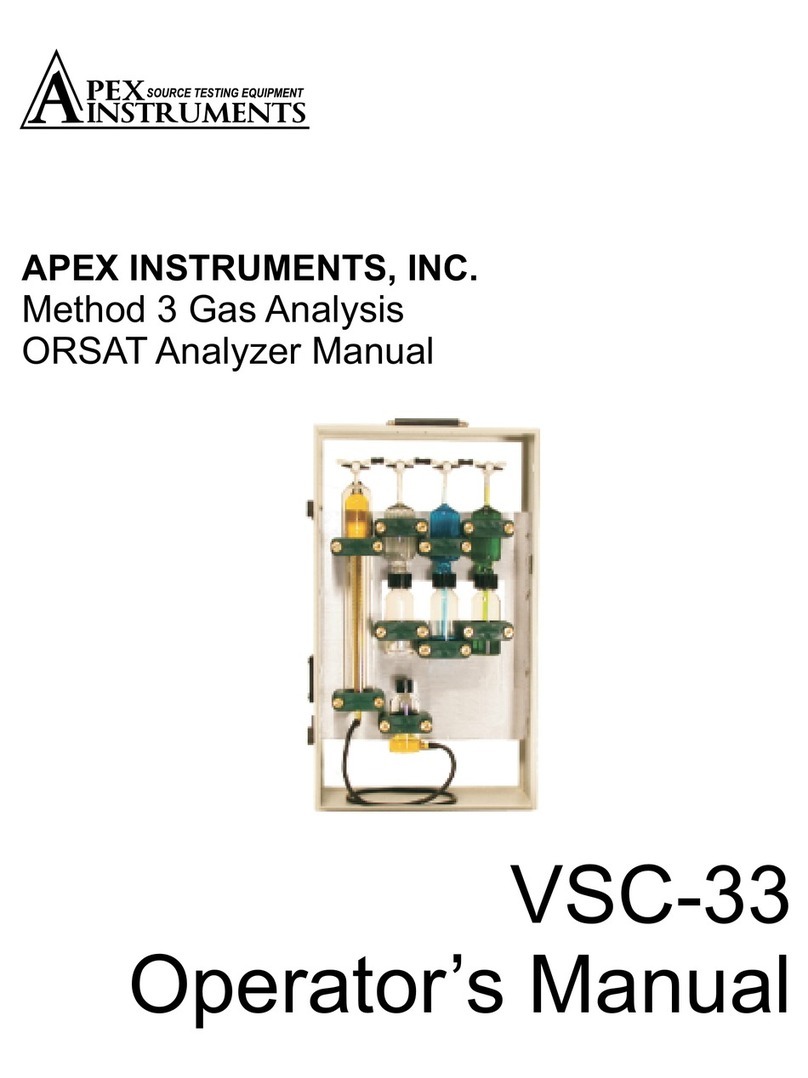
Apex Instruments
Apex Instruments VSC-33 Operator's manual
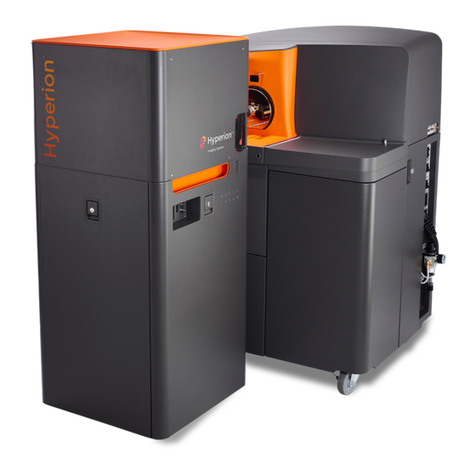
Fluidigm
Fluidigm Hyperion user guide

ARA
ARA mini 6-RC quick start guide

Agilent Technologies
Agilent Technologies E6000C user guide
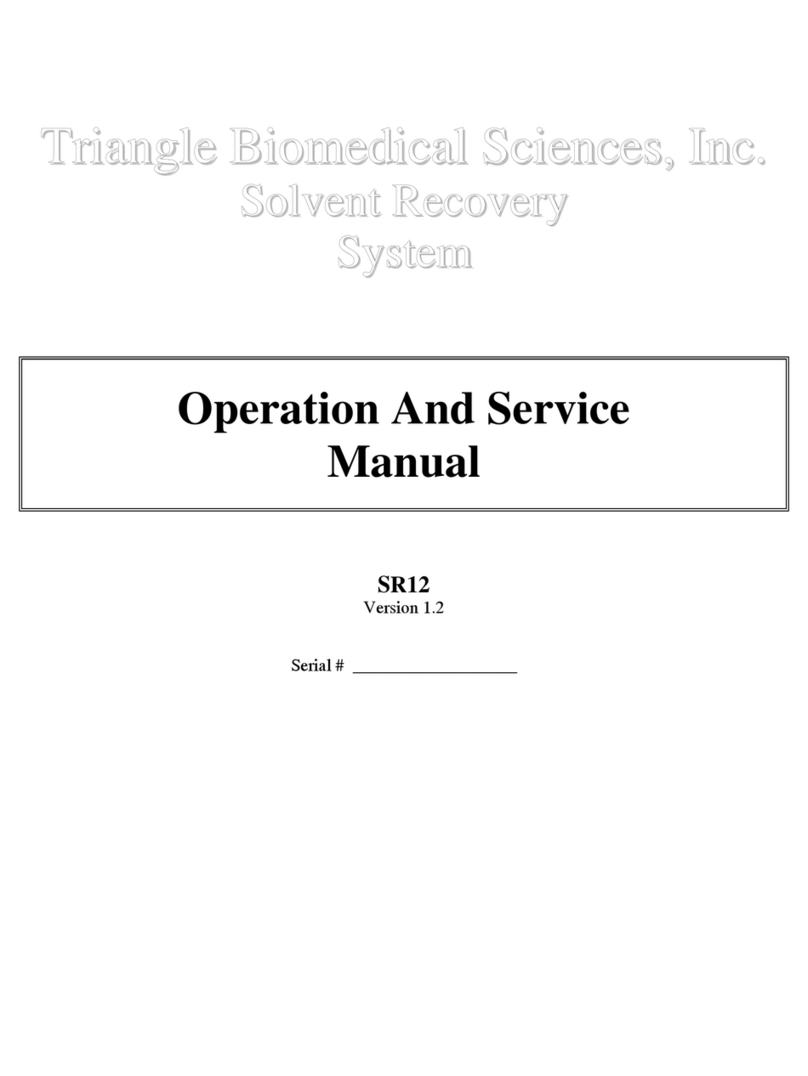
tbs electronics
tbs electronics SR12 Operation and service manual
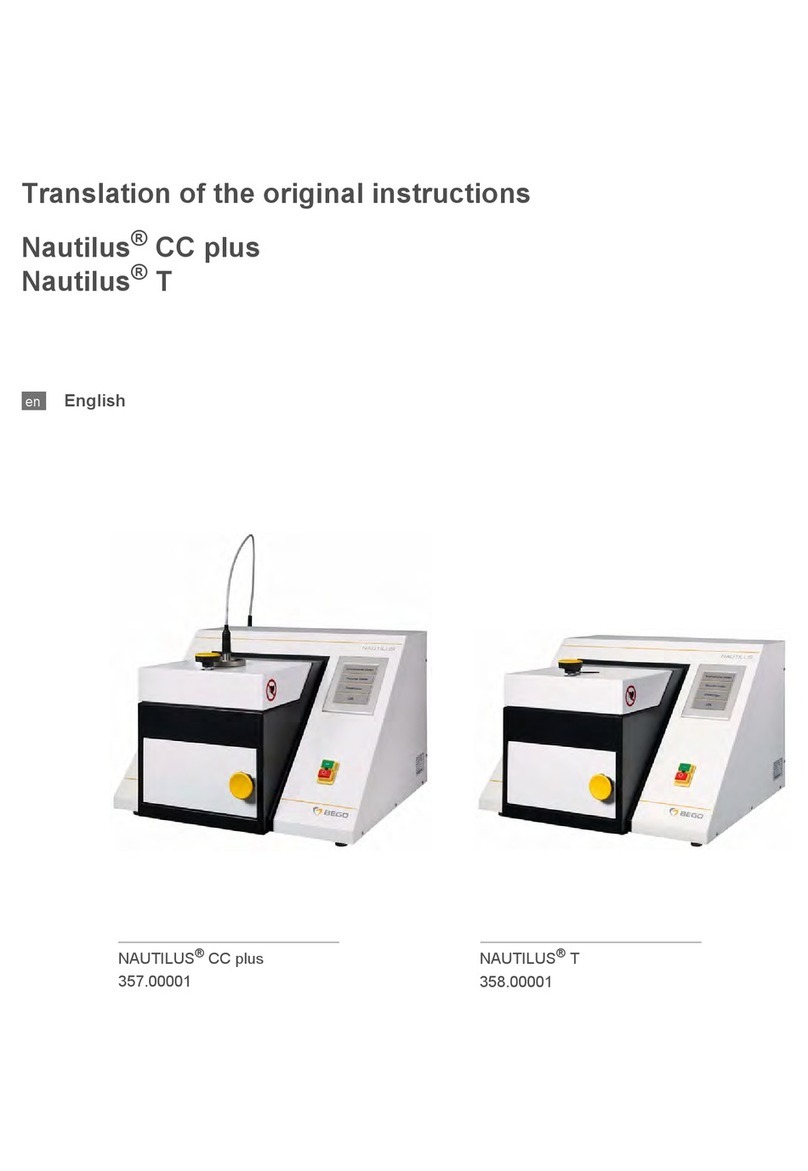
Bego
Bego Nautilus CC plus Translation of the original instructions
